Frequently Asked Questions About Rolfing®
“Fascia is the organ of posture...the body is a web of fascia.”
Ida Rolf, PhD., Founder of Rolfing
What is the cost?
Each session is 90 minutes long and costs $130. (Price subject to change. Please inquire.)
Who would benefit from Rolfing®?
Almost anyone. The goal of Rolfing - alignment of the body in gravity - is to provide a body with increased well-being through enhanced balance, movement, and stress release. In this way, Rolfing can be a preventative measure for many structural problems that occur from aging, poor posture, or repetitive movement. Occasionally children receive Rolfing, although the sessions are much shorter than adult sessions. In my practice I have worked with folks as young as two years of age and as old as ninety-seven!
Is Rolfing a type of massage?
No. The focus of Rolfing is on integrating the structure, so that gravity is a supportive element. Massage works directly on the muscles, where Rolfing concentrates on the connective tissue. The results of Rolfing tend to be longer lasting and more corrective than massage. Rolfing’s strategy is designed to allow the body to sustain the changes that are made. Additionally, most Rolfing sessions incorporate client participation and movement education.
How does Rolfing align the body?
Rolfing systematically organizes the body by working on the body’s connective tissue, primarily fascia. The human body holds itself erect with pairs of muscle groups functioning within a network of fascial sheaths. Normally, when one of the pair contracts, the other must extend to maintain proper balance.

What is the Rolfing Ten Session Series?
The basic Rolfing series consists of ten sessions. Each Rolfing session builds upon the results of the previous one, so that the results are cumulative. The first seven sessions remove strain from specific areas of the body: the lower back, neck, knees, etc. The remaining sessions integrate the body as a whole.
A Rolfer starts by evaluating the client's structure and movement, so that each session is unique to the individual, while still achieving the goals of that particular session.
Sessions are 90 minutes. The amount of time between sessions varies and is determined on an individual basis. The average spacing is a week to two weeks apart, although, in most cases, they can be as much as a month apart while still receiving maximum benefits. The integration time between sessions is often as important as the session itself.
Do I have to take the entire series?
I would never require someone to commit to taking the whole series upfront (because they have not yet experienced the work), but there is an order to the work that is necessary to achieve optimum results. If someone were to not complete the series, the best places to stop are after the first, third, or seventh sessions.
How Does Rolfing Feel?

Does Rolfing last?
Yes. Photographs show that the changes of the basic Rolfing series are still present many years after the series is complete. On the other hand, as bodies change, or if someone incurs an injury, or has an accident, a physically demanding occupation or stressful situation, additional work my be useful. At that time, Advanced Sessions of Rolfing are recommended.
What kind of training is required for Rolfers?
Even though all Rolfers in Florida are required to be licensed under massage therapy, massage certification is only the first pre-requisite for the Rolfing training. Rolfing students must also get ten sessions of Rolfing, Rolf Movement sessions, and do case studies before entering the basic training, which consists of two nine-week periods of training and the completion of an anatomical thesis. Advanced Rolfers have an additional nine weeks of training, plus a minimum of three years of practice. Rolfing Movement Practitioners have taken an additional month of movement training.
While it’s not a requirement, most Rolfers these days have achieved additional training in cranial/sacral and visceral/neural work that can stand alone or be used to enhance Rolfing sessions.
1850 Lee Road, Suite # 108, Lee World Center, Winter Park, FL 32789 407-645-2309 robynrolf@gmail.com
MM15585 MA25820